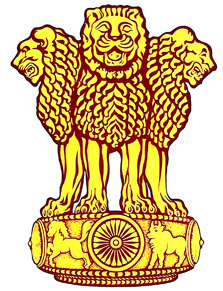National Emblem of India
 National
Emblem of India - An Ashokan pillar at Sarnath near Varanasi in Uttar
Pradesh depicts four lions on the top standing back to back. Its base has an elephant,
a horse, a bull and a lion separated by intervening wheels over a bell-shaped lotus
and a Dharma Chakra or the Wheel of Law carved on it. This symbol was adopted as
the National Emblem of India by the Indian Government on 26th January 1950. The
two-dimensional picture of this emblem has become the official symbol of the government
now that only shows three of the four lions and the base having the Dharma Chakra
in the center and a bull and horse on either side and an engraved phase that reads
'Satyameva Jayate' in the Devanagari script. The phrase is translated to mean 'Truth
alone triumphs'.
National
Emblem of India - An Ashokan pillar at Sarnath near Varanasi in Uttar
Pradesh depicts four lions on the top standing back to back. Its base has an elephant,
a horse, a bull and a lion separated by intervening wheels over a bell-shaped lotus
and a Dharma Chakra or the Wheel of Law carved on it. This symbol was adopted as
the National Emblem of India by the Indian Government on 26th January 1950. The
two-dimensional picture of this emblem has become the official symbol of the government
now that only shows three of the four lions and the base having the Dharma Chakra
in the center and a bull and horse on either side and an engraved phase that reads
'Satyameva Jayate' in the Devanagari script. The phrase is translated to mean 'Truth
alone triumphs'.
Ashoka was a great Mauryan King who was known far and wide for converting to Buddhism
after seeing the after effects of the war imposed by him on the small states surrounding
him, especially on Kalinga. He was said to be full of remorse seeing the ill effects
his ambition had brought on the soldiers and families from both the sides. His emblem
has now become the official seal of the President of India and Central and State
Governments of the Indian union. Ashoka erected the Lion Capital in the 3rd century
BC to mark the spot where Buddha first proclaimed his gospel of peace. Now, it is
symbolic of India's commitment to world peace and goodwill. The three lions visible
in the emblem symbolize power, courage and confidence. This State emblem is used
only for official purposes and commands utmost respect and loyalty.